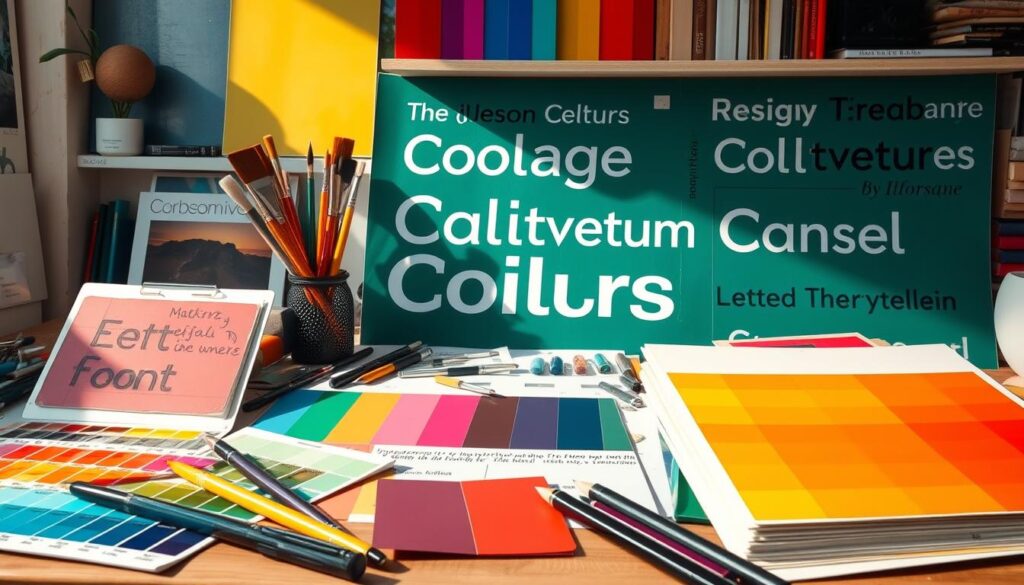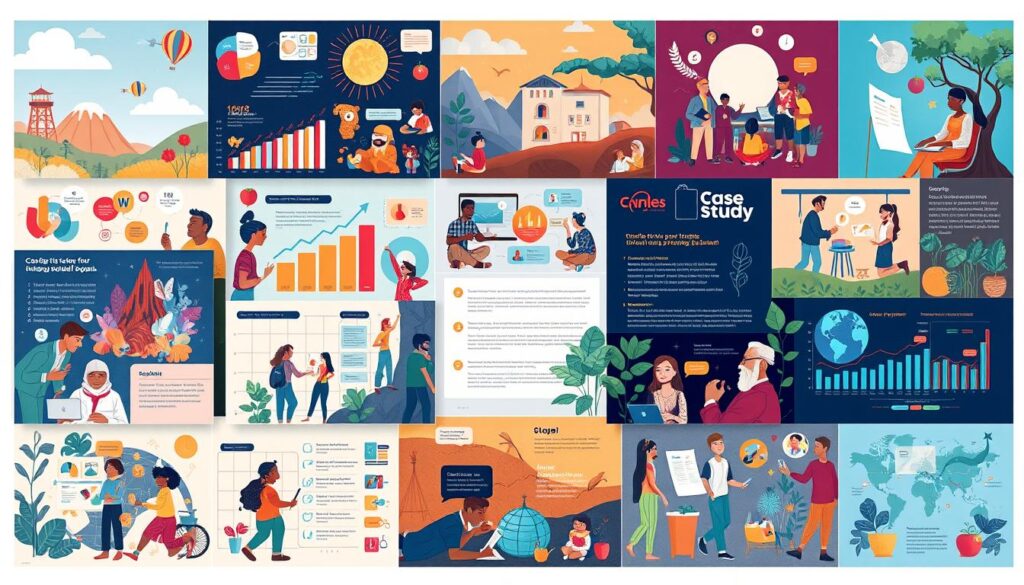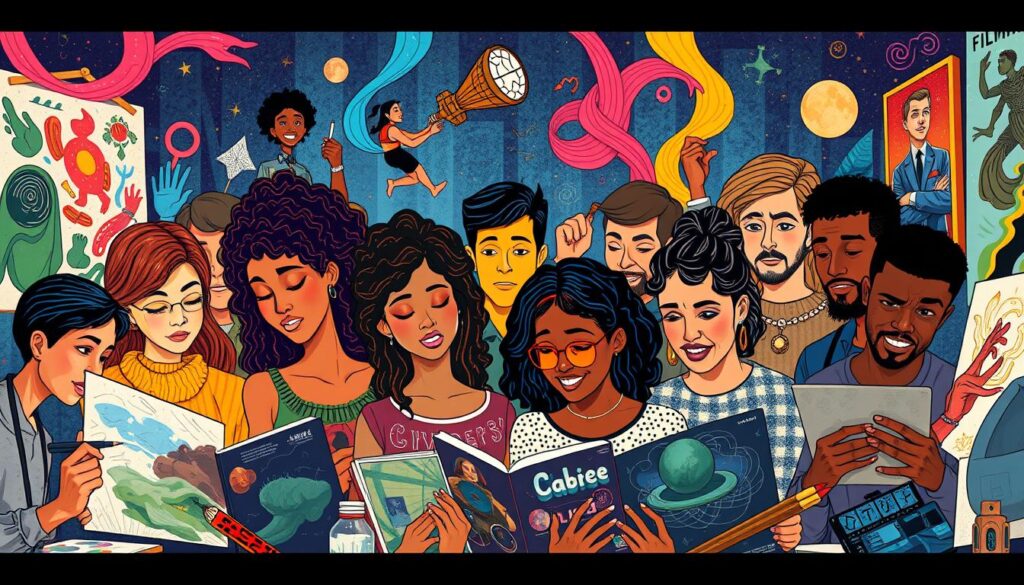In today’s fast-paced digital landscape, mastering visual storytelling is essential for brands aiming to engage your audience effectively. By integrating captivating visuals into communication strategies, complex ideas become more accessible and relatable. Visual storytelling, which skillfully combines art, psychology, and communication, allows brands and individuals to connect on an emotional level, enhancing their engagement. Research indicates that visuals are processed 60,000 times faster than text, making it imperative to adopt visual storytelling strategies in any effective communication plan.
Key Takeaways
- Visual storytelling significantly enhances audience engagement.
- Visuals make complex ideas easier to understand.
- Combining art and psychology boosts emotional connection.
- Effective communication relies heavily on the use of visuals.
- Visuals are processed much faster than text by the human brain.
The Importance of Visual Storytelling in Communication
The significance of visual storytelling cannot be overstated in today’s fast-paced world. Visuals have a unique capacity to simplify complex information while engaging audiences emotionally. This method of communication enhances retention, as people are more likely to remember information presented visually rather than through text alone. Studies indicate that visuals are remembered significantly better than spoken words, showcasing their essential role in successful communication strategies.
Visual narratives break down barriers in understanding, accommodating various learning styles and preferences. By integrating images, infographics, and videos with text, communicators can appeal to diverse demographics. Research shows that effective visual communication fosters inclusivity, reaching audiences who may struggle with traditional text-based formats. This adaptability exemplifies the importance of visual storytelling in creating effective connections between brands and consumers.
Incorporating visuals into communication efforts not only boosts clarity but also reinforces emotional connections. Audiences often engage more fully with content that resonates on a visual level, allowing for a deeper understanding of the message. Those looking to strengthen their communication strategies should prioritize the importance of visual storytelling to engage effectively with their audiences.
Understanding Visual Narratives and Their Impact
The world of visual narratives plays a crucial role in shaping communication strategies across various platforms. The impact of visuals goes beyond aesthetics; it engages audiences on a psychological level. By intertwining storytelling dynamics with compelling images and designs, brands can foster deeper connections with their viewers. Behavioral studies show that individuals are more inclined to interact with and trust brands that leverage effective storytelling techniques.
Different forms of visual narratives, such as infographics, videos, and illustrations, serve distinct purposes but share a common goal: conveying brand messages clearly and engagingly. Infographics distill complex information into easily digestible visuals, while videos weave narratives that can evoke strong emotional responses. Illustrations add a unique voice to storytelling, offering creativity that standard photography may lack.
To illustrate the variety and effectiveness of visual narratives, consider the following table showcasing different formats and their unique benefits:
| Format | Description | Impact of Visuals |
|---|---|---|
| Infographics | Combines data and visuals to present information succinctly. | Enhances understanding and retention of complex concepts. |
| Videos | Dynamic storytelling through moving images and sound. | Creates emotional connections, often leading to higher engagement. |
| Illustrations | Drawings or digital art used to convey ideas uniquely. | Captures audience attention with creativity and uniqueness. |
Understanding these elements underscores the significance of visual narratives in a brand’s storytelling arsenal. As brands harness the impact of visuals, they not only tell their story but also create lasting impressions on their audience.
Visual Storytelling Techniques for Effective Engagement
Visual storytelling techniques play a crucial role in optimizing audience engagement. By utilizing compelling imagery and effective storytelling methods, brands can create memorable experiences that resonate with viewers. A primary technique involves the use of metaphors. Images that symbolize deeper meanings can elevate the understanding and emotional impact of a narrative.
Sequential storytelling stands out as another effective approach. Organizing visuals in a logical or chronological order naturally guides the audience through the narrative, ensuring clarity and engagement. Traditional stories often follow a framework featuring conflict and resolution, which enhances emotional engagement. Audiences find themselves more invested in narratives that evoke feelings, urging them to share and discuss the content.
Moreover, incorporating interactive elements greatly enhances audience participation. Techniques such as polls, quizzes, or user-generated content invite the audience to engage directly with the storytelling process. This not only fosters a deeper connection but also encourages viewers to become active participants rather than passive observers.
Successful brands, such as Coca-Cola and Nike, illustrate the power of visual storytelling techniques in their marketing strategies. These brands effectively utilize imagery that resonates with their values and missions, successfully capturing and maintaining audience attention.
Crafting Your Visual Content Marketing Strategy
Effective visual content marketing demands careful strategy development. Begin by defining target audience personas to understand who interacts with your brand. Knowing their interests, demographics, and preferences can tailor your visual storytelling to resonate and engage.
Establish clear brand storytelling goals. This includes identifying the key messages you wish to convey through visuals and how they align with your overall marketing objectives. Whether launching a new product or promoting a brand initiative, a well-defined narrative can guide your content creation process.
Map out content formats that best fit your narrative. For instance, infographics may suit data-driven stories, while short videos could enhance emotional connections. Consider the platform where the content will be shared, as it influences the choice of format.
Insights from recent content marketing research indicate that a structured approach can significantly enhance reach and improve conversion rates. By understanding which visual elements perform best, brands can adapt their strategies accordingly to maximize impact.
Incorporate essential tools to assist in planning and executing campaigns. Solutions like Trello for organization, Canva for design, and Hootsuite for scheduling can streamline your workflow, allowing for more focus on creativity and storytelling.
- Define target audience personas
- Establish clear brand storytelling goals
- Map content formats to narrative
- Utilize insights from research
- Incorporate essential planning tools
Key Elements of Visual Branding
Visual branding plays a crucial role in shaping a brand identity that resonates with consumers. The fundamental components include logos, color schemes, typography, and imagery. Each element contributes to the creation of a cohesive and recognizable visual presence that distinguishes one brand from another.
Logos serve as the visual cornerstone of brand identity. A well-designed logo encapsulates the essence of a brand in a single graphic, making it memorable. For instance, the simplicity of Apple’s logo exemplifies how effective visual branding can be achieved.
Color schemes significantly influence emotional responses. Different colors evoke distinct feelings, thus serving as visual cues that enhance brand recognition. For example, Nike’s use of black and white signifies strength and elegance, aligning with their brand values.
Typography is another essential aspect that influences visual consistency. The choice of fonts can alter the perception of a brand. Clean, modern fonts often suggest innovation, while serif fonts may communicate tradition. Establishing a uniform typography across various platforms reinforces brand identity and ensures visual consistency.
Imagery, including photographs and illustrations, should align with the brand’s narrative. High-quality, relevant images that resonate with the target audience enhance engagement and brand loyalty. For example, Coca-Cola’s iconic imagery often evokes a sense of happiness and togetherness, which aligns with their brand message.
To summarize the impact of these key components on brand identity, here is a detailed comparison of some successful brands:
| Brand | Logo | Color Scheme | Typography | Imagery |
|---|---|---|---|---|
| Apple | Simple apple icon | Black, White, Gray | Modern Sans Serif | Minimalist product images |
| Nike | Swoosh | Black, White | Bold, Clear fonts | Dynamic athletic imagery |
| Coca-Cola | Classic script | Red, White | Curvy Serif | Joyful, lifestyle photos |
Maintaining visual consistency across these elements strengthens brand identity and fosters trust and loyalty among consumers. The strategic use of visual branding not only enhances recognition but also plays a vital role in shaping the overall narrative of a brand.
Creating Compelling Visual Content
Effective visual content hinges on a careful selection of images, colors, and fonts. When executed properly, these components create compelling visuals that resonate with an audience. The right visuals enhance narrative clarity, ensuring that key messages are communicated effectively. Research indicates that relevant imagery increases message retention by up to 65 percent. Choosing visuals that align with your brand’s story and audience preferences becomes essential for successful storytelling.
Choosing the Right Visuals
Selecting visuals that complement your content involves understanding your audience and the story you wish to convey. Compelling visuals should evoke emotions and draw the viewer into the narrative. Consider the following elements when choosing your imagery:
- Relevance: Ensure images relate directly to your message.
- Quality: Use high-resolution images for a professional appearance.
- Diversity: Include varied visuals to appeal to a broad audience.
Using Colors and Fonts Effectively
Color theory in design plays a crucial role in shaping perceptions. Different colors invoke specific emotions; for instance, blue conveys trust, while red evokes excitement. By leveraging color effectively, brands can influence consumer behavior and enhance engagement. Additionally, font selection is vital. Readability and style can dramatically impact how a message is received. Optimal combinations can reinforce a brand’s identity and make the content easily digestible.
To illustrate the impact of colors and fonts, the following table details the emotions associated with various colors and then pairs them with suitable font selections:
| Color | Emotion | Recommended Fonts |
|---|---|---|
| Blue | Trust | Helvetica, Arial |
| Red | Excitement | Impact, Futura |
| Green | Growth | Garamond, Verdana |
| Yellow | Optimism | Comic Sans, Times New Roman |

Visual Storytelling Strategies for Different Platforms
In a digital landscape filled with diverse platforms, employing effective visual storytelling strategies becomes essential for capturing audience engagement. Each platform has unique characteristics that influence how stories can be presented. For instance, tailored storytelling on Instagram often involves vibrant images and reels that quickly draw viewers in, making it ideal for showcasing a brand’s personality and culture.
YouTube, with its long-form video capabilities, allows for deeper narratives. Brands can explore complex ideas, showcase products, or share customer testimonials, promoting a richer audience experience. The platform strategies here focus on narrative depth, pacing, and engaging visuals that resonate with viewers over extended viewing sessions.
On LinkedIn, visual storytelling leans toward professionalism. Infographics and data visualization attract professionals aiming to digest complex information quickly. Companies can leverage this platform to share industry insights or thought leadership, increasing audience engagement through informative content.
Consider how TikTok relies on short-form video storytelling. Here, the challenge lies in capturing attention within mere seconds. Brands thrive by generating entertaining and relatable content, often utilizing trends and music to amplify their message. This format requires an adaptive approach, utilizing platform strategies that prioritize concise and impactful storytelling.
Below is a comparison of effective visual storytelling strategies across various platforms:
| Platform | Content Type | Strategy Focus | Audience Engagement |
|---|---|---|---|
| Images, Stories, Reels | Visual appeal, branding | Interactive polls, comments | |
| YouTube | Long-form Videos | Narrative depth, storytelling | Subscriptions, shares |
| Infographics, Articles | Professional insights, analysis | Networking, engagements | |
| TikTok | Short-form Videos | Trend-based, quick capture | Likes, shares, comments |
Effectively using tailored storytelling across these platforms amplifies audience engagement and sets brands apart in a crowded marketplace. In understanding each platform’s unique attributes, brands can craft immersive and engaging visual narratives that leave a lasting impression.
The Role of Visual Storytelling in Social Media
Visual storytelling has transformed the way brands engage with their audiences on social media platforms. Instagram and Facebook, in particular, have become prime channels for implementing social media storytelling effectively. Utilizing captivating visuals can significantly boost interaction rates, making it essential for brands to adopt visual content best practices tailored to each platform.
Best Practices for Instagram and Facebook
When crafting visual narratives for Instagram and Facebook, several critical strategies can enhance engagement:
- Utilize high-quality images and videos to capture attention quickly.
- Incorporate storytelling elements that resonate with your audience’s emotions.
- Implement platform-specific strategies like Instagram Stories or Facebook Live broadcasts to maximize reach.
- Use consistent branding elements, such as color schemes and typography, to create a recognizable identity.
- Encourage audience participation through polls or user-generated content, fostering a community feel.
Research highlights that posts with visuals on Facebook garner 2.3 times more engagement than text-only posts, emphasizing the importance of these strategies. Campaigns that incorporate engaging visual storytelling not only attract attention but also bolster brand loyalty and community building.
| Platform | Visual Content Best Practices | Engagement Tip |
|---|---|---|
| Use high-quality images, compelling captions. | Leverage hashtags for broader reach. | |
| Mix videos with infographics and live content. | Post during peak times for maximum visibility. | |
| Instagram Stories | Incorporate interactive stickers and polls. | Create urgency with time-sensitive offers. |
| Facebook Ads | Use targeted visuals tailored to your demographics. | Test different ad variations for effectiveness. |
Tools for Enhancing Your Visual Storytelling
In the evolving landscape of visual storytelling, leveraging the right tools can greatly enhance your content creation process. Utilizing various software solutions allows creators to execute their ideas effectively, ensuring that their visual narratives captivate and engage audiences. Exploring both content creation software and online resources for design inspiration can amplify your storytelling efforts.
Software Solutions for Content Creation
Content creation software plays a crucial role in producing compelling visuals. Leading options such as Adobe Creative Suite and Canva provide robust features that cater to a range of creative needs. Adobe Creative Suite, renowned for its comprehensive tools like Photoshop and Illustrator, allows for intricate design work and photo editing. Canva, on the other hand, offers user-friendly templates that simplify the design process, making it accessible for beginners.
- Adobe Creative Suite: Ideal for professional-level graphics and editing.
- Canva: Perfect for quick designs and marketing materials.
Online Resources for Design Inspiration
Staying inspired is key to effective visual storytelling. Online platforms like Behance and Dribbble provide vast galleries of creative work. These resources not only showcase finished pieces but also offer valuable insights into trending styles and techniques. Engaging with these design communities helps practitioners refine their skills while gaining exposure to fresh ideas.
- Behance: A platform for showcasing and discovering creative work across multiple fields.
- Dribbble: Offers a space for designers to share, find inspiration, and connect with peers.
| Tool | Type | Features |
|---|---|---|
| Adobe Creative Suite | Content Creation Software | Photo Editing, Vector Graphics, Prototyping |
| Canva | Content Creation Software | User-Friendly Templates, Collaboration Tools |
| Behance | Design Inspiration | Portfolio Showcasing, Networking, Feedback |
| Dribbble | Design Inspiration | Peer Interaction, Sharing, Discovering Trends |
Visual Content Design: Aesthetic vs. Narrative
Effective visual content design requires a careful balance between aesthetic appeal and narrative storytelling. While captivating visuals can draw in an audience, a compelling narrative sustains their interest throughout the experience. This interplay highlights the importance of both elements in creating engaging content.
Aesthetic appeal is crucial for grabbing attention in an overstimulated environment. Well-chosen colors, compelling imagery, and innovative layouts work together to create a stunning first impression. On the other hand, narrative storytelling enriches the audience’s interaction by instilling meaning and emotion within the visuals. It allows viewers to connect on a deeper level, enhancing retention and engagement.
The integration of these elements can be measured through various design metrics. For example, analytics tools can track engagement rates and viewer responses, providing insights into how well a piece combines both aesthetic qualities and narrative depth. This information is invaluable for optimizing visual content design for different audiences and platforms.
Case studies reveal that brands excelling at merging aesthetics with storytelling achieve heightened audience loyalty and increased shareability of their content. Noteworthy examples often showcase how visual elements weave seamlessly into narratives that resonate with viewers on multiple levels, affirming the long-term effectiveness of such strategies.
| Element | Aesthetic Appeal | Narrative Storytelling |
|---|---|---|
| Definition | Visual elements that attract and engage | Connected messages that evoke feelings |
| Impact | Creates initial interest and visual delight | Fosters emotional connection and engagement |
| Application | Color, typography, composition | Plot structure, character development, themes |
| Metrics | Click-through rates, impressions | Viewer retention, shares, comments |
Measuring the Effectiveness of Your Visual Storytelling
Understanding how to measure effectiveness in visual storytelling plays a crucial role in enhancing engagement. Organizations need to focus on various storytelling metrics to evaluate their campaigns and refine their strategies.
One key approach involves analyzing engagement rates, which offer insights into how well the audience responds to visual content. High engagement rates indicate a positive audience response, while low rates may suggest the need for adjustments in the narrative or visuals used.
Feedback from the audience serves as another vital component. Gathering qualitative data through surveys or social media interactions allows creators to understand audience preferences. This feedback can significantly impact future projects, guiding the direction of visual narratives.
Additionally, utilizing analytics tools enables brands to track viewer behavior, providing quantitative data that illustrates how audiences interact with content over time. Metrics such as watch time and click-through rates provide valuable insights into the effectiveness of storytelling efforts.
A/B testing offers another effective strategy. By comparing two different pieces of content to see which resonates more with the audience, firms can develop a stronger understanding of what captures attention. Establishing clear KPIs (Key Performance Indicators) tailored to storytelling objectives is essential for measuring specific outcomes.
| Storytelling Metric | Description | Importance |
|---|---|---|
| Engagement Rate | Ratio of interactions to total views | reflects audience interest |
| Audience Feedback | Reviews and comments from viewers | provides qualitative insights |
| Watch Time | Total time spent watching content | indicates content effectiveness |
| Click-Through Rate | Percentage of viewers clicking on links | measures engagement with calls to action |
Effective measuring of visual storytelling impacts the overall strategy. Brands that prioritize these methodologies can ensure their narratives resonate with audiences and adapt as necessary for sustained engagement.
Case Studies: Successful Applications of Visual Storytelling
Visual storytelling success can be seen through various real-world applications by renowned brands. National Geographic stands out with its compelling imagery that educates and captivates audiences. Their campaigns often explore themes of conservation and environmental awareness, utilizing stunning visuals coupled with engaging narratives. This approach not only attracts views but also inspires action, as evidenced by their increasing engagement rates on digital platforms.
Similarly, Airbnb has harnessed the power of visuals to promote unique travel experiences. Their “Live There” campaign featured a combination of heartfelt stories and striking visuals showcasing host homes and local cultures. By focusing on storytelling, Airbnb effectively connected guests to destinations, facilitating emotional engagement and driving bookings.
Both case studies illustrate critical strategies that contribute to visual storytelling success. Companies should prioritize audience connection through authentic narratives and high-quality visuals. Lessons learned from these examples provide actionable insights for brands looking to enhance their visual storytelling techniques.

| Brand | Campaign Name | Objectives | Strategies Employed | Measurable Outcomes |
|---|---|---|---|---|
| National Geographic | Wildlife Conservation | Raise awareness for endangered species | Stunning visuals, social media engagement, narratives | Increased follower count by 30% |
| Airbnb | Live There | Encourage travelers to immerse in local cultures | Emotional storytelling, host and guest testimonials, rich imagery | Boosted bookings by 25% |
These examples reinforce the effectiveness of integrating visual elements with strategic storytelling. By analyzing these case studies, brands can adopt similar tactics to achieve visual storytelling success in their campaigns.
Conclusion
Mastering visual storytelling is essential for brands and marketers aiming to engage audiences effectively in today’s fast-paced digital landscape. Throughout this article, we explored how powerful visuals can enhance narratives, making complex information more digestible and memorable. Key takeaways include the necessity of aligning your visuals with the overarching message to ensure coherence while leveraging various strategies tailored for different platforms.
Additionally, we highlighted the importance of utilizing the right tools and resources to create compelling visual content. By incorporating innovative software solutions and drawing inspiration from notable design trends, marketers can significantly elevate their storytelling capabilities. As you innovate your communication strategies, remember that visual storytelling isn’t just a trend—it’s a fundamental practice that fosters deeper connections with your audience.
Ultimately, embracing this approach not only enhances brand recognition but also enriches the overall consumer experience. Reflecting on these insights encourages a proactive stance towards refining your visual storytelling methods, paving the way for more engaging and impactful marketing endeavors. Now is the time to harness the potential of visual narratives and set your communications apart in a crowded marketplace.



